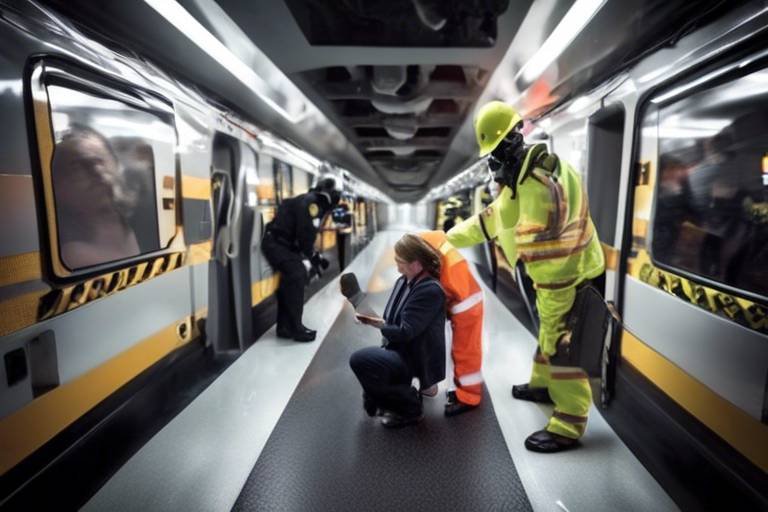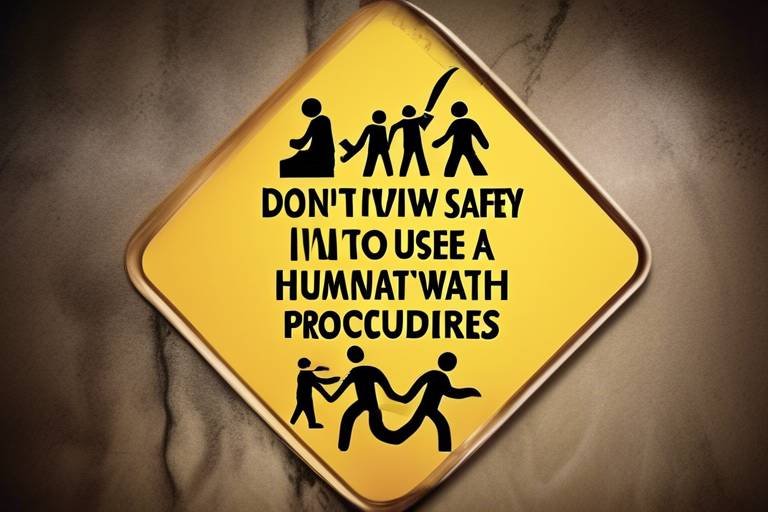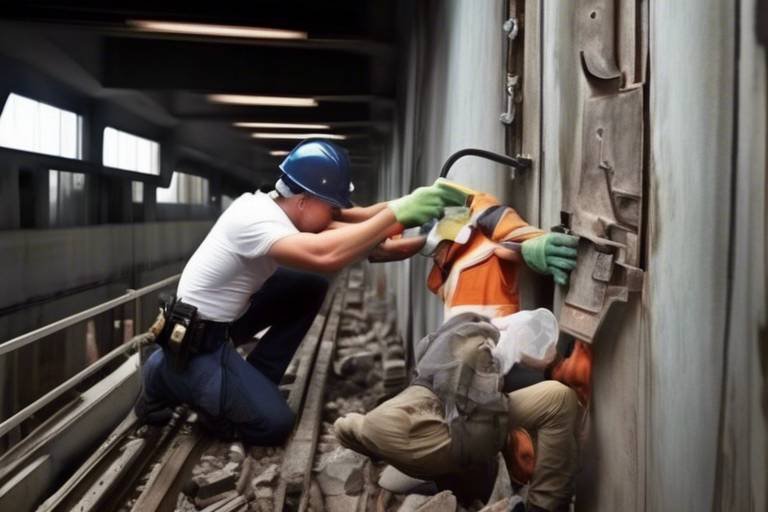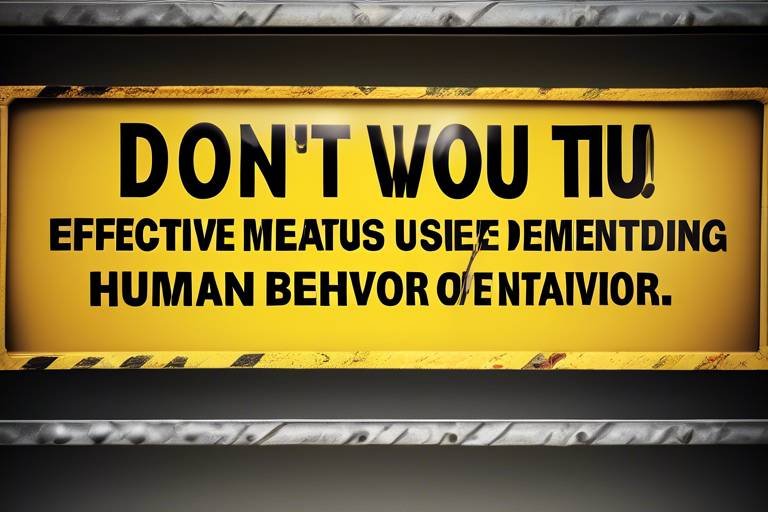How Human Behavior Dictates The Effectiveness of Safety Protocols
In today's fast-paced world, safety protocols are more important than ever. But have you ever wondered why some safety measures seem to work like a charm while others fall flat? The secret often lies in the intricate dance of human behavior. Our actions, perceptions, and even our emotions play a significant role in how effective these safety protocols are. This article explores the relationship between human behavior and safety protocols, shedding light on how individual actions can dramatically influence safety outcomes across various environments.
Understanding the psychological factors that drive compliance with safety protocols is crucial for enhancing their effectiveness. Why do some people follow safety rules to the letter while others dismiss them? It all comes down to motivations, social influences, and cognitive biases. For instance, individuals might comply with safety protocols due to a genuine concern for their well-being or the well-being of others. On the flip side, social influences—like peer pressure or workplace culture—can either encourage or discourage adherence. Cognitive biases, such as the optimism bias (the belief that bad things won't happen to us), can also lead to a disregard for safety measures. Recognizing these factors is the first step in crafting protocols that resonate with individuals on a personal level.
Effective training and education programs are essential for instilling safety protocols in individuals. Imagine trying to memorize a complex safety procedure without any guidance. It can feel overwhelming! That's why best practices in safety training focus on making the learning process engaging and memorable. Programs that combine theory with practical application not only improve knowledge retention but also foster a behavioral change. When individuals understand the 'why' behind a safety protocol, they're more likely to embrace it. In this context, the training process becomes less about rote memorization and more about cultivating a culture of safety.
Utilizing interactive training methods, such as simulations and role-playing, can significantly enhance engagement and retention of safety protocols. Think of it this way: would you rather learn to drive a car in a classroom or behind the wheel? The latter offers real-world experience that sticks with you. Similarly, interactive training allows individuals to practice safety measures in a controlled environment, making the learning experience both impactful and relevant. This hands-on approach not only builds confidence but also encourages participants to internalize safe behaviors.
Analyzing case studies on simulation training reveals its impact on behavior change and safety compliance. For example, in the healthcare industry, simulation-based training has been shown to reduce medical errors significantly. By immersing healthcare professionals in realistic scenarios, they can practice their responses to emergencies without the risk of real-world consequences. Such successful implementations provide invaluable lessons for other industries, demonstrating that when individuals are equipped with the right tools and experiences, they are more likely to follow safety protocols diligently.
Incorporating feedback mechanisms into training programs can significantly improve learning outcomes. Have you ever received constructive criticism that helped you grow? That's the power of feedback! When participants receive timely and specific feedback about their performance, it enhances their understanding and application of safety protocols. This continuous loop of feedback fosters a growth mindset, encouraging individuals to strive for improvement and take ownership of their safety practices.
Sustaining long-term behavior change requires ongoing support and reinforcement. It's not just about a one-time training session; it's about creating a culture where safety is prioritized every day. Strategies such as reminders, incentives, and community involvement can help maintain safety compliance over time. For instance, regular safety meetings or recognition programs for safe practices can keep safety at the forefront of everyone's mind. When individuals feel supported and valued for their commitment to safety, they're more likely to stick with it in the long run.
Organizational culture plays a pivotal role in shaping employee behavior regarding safety protocols. A strong safety culture can foster compliance and reduce accidents in the workplace. But what does a strong safety culture look like? It’s characterized by open communication, shared values, and a commitment to safety at all levels. When employees feel that their organization genuinely cares about their safety, they are more likely to comply with protocols and even contribute to their improvement. This creates a positive feedback loop that enhances overall safety outcomes.
Leadership commitment to safety is essential for cultivating a positive safety culture. Leaders set the tone for safety practices within their organizations. When leaders model safe behaviors and prioritize safety in their decision-making, they send a powerful message to their teams. It's like a captain steering a ship; if the captain is focused on navigating safely, the crew is more likely to follow suit. Leaders can also promote a culture of accountability, where everyone feels responsible for maintaining safety standards.
Engaging employees in safety practices enhances their sense of ownership and responsibility. When employees are involved in safety discussions and decision-making processes, they are more likely to feel invested in the outcomes. Initiatives such as safety committees or suggestion programs can empower employees to voice their concerns and contribute to safety improvements. This not only boosts morale but also fosters a collaborative environment where everyone works together towards a common goal: safety.
Behavioral economics provides insights into how individuals make decisions regarding safety. Concepts such as risk perception and choice architecture play a crucial role in understanding safety protocol effectiveness. For instance, if a safety protocol is perceived as too complex or time-consuming, individuals may be less likely to follow it. Understanding these behavioral nuances allows organizations to design safety measures that align with human decision-making processes, ultimately leading to better compliance.
Implementing nudges can subtly influence individuals towards safer behaviors. Think of nudges as gentle pushes in the right direction. Simple changes, like placing hand sanitizers in easily accessible locations or using clear signage to remind employees of safety protocols, can significantly impact behavior. These small adjustments can create an environment that naturally encourages compliance without the need for heavy-handed enforcement.
Risk perception significantly affects how individuals respond to safety protocols. Factors such as personal experiences, media coverage, and social norms shape our understanding of risk. By examining these factors, organizations can tailor their safety measures to address common misconceptions and fears. When individuals feel that safety protocols are relevant and address their specific concerns, they are more likely to adhere to them.
- What are safety protocols? Safety protocols are guidelines and procedures designed to ensure the safety and well-being of individuals in various environments.
- Why is human behavior important in safety protocols? Human behavior influences compliance, risk perception, and overall effectiveness of safety measures.
- How can organizations improve safety compliance? Organizations can improve safety compliance through effective training, leadership commitment, and fostering a strong safety culture.
- What role does feedback play in safety training? Feedback helps individuals understand their performance and encourages continuous improvement in safety practices.

The Psychology of Compliance
Understanding the psychological factors that drive compliance with safety protocols is not just a matter of following rules; it’s about grasping the intricate web of motivations, social influences, and cognitive biases that shape our behaviors. Imagine trying to convince someone to wear a seatbelt. It’s not just about the law; it’s about their perception of risk, the influence of peers, and even their past experiences. When we delve into the psychology behind compliance, we find that it’s a complex interplay of various elements that can either encourage or discourage adherence to safety measures.
At the heart of compliance lies motivation. People are more likely to follow safety protocols when they understand the personal benefits involved. For instance, if employees perceive that wearing personal protective equipment (PPE) not only keeps them safe but also enhances their overall well-being, they are more inclined to comply. This sense of personal gain can be a powerful motivator. However, the opposite is also true; if individuals see safety measures as burdensome or unnecessary, their compliance will likely dwindle.
Social influences play a significant role in shaping behavior as well. Humans are inherently social creatures, and the actions of peers can greatly impact individual choices. If a person notices their colleagues consistently adhering to safety protocols, they are more likely to follow suit. Conversely, if they observe lax attitudes towards safety, they may feel justified in ignoring protocols themselves. This phenomenon can be illustrated through the concept of social proof, where people look to the behaviors of others to guide their own actions.
Cognitive biases also come into play when discussing compliance. For instance, the optimism bias leads individuals to believe that they are less likely to experience negative outcomes compared to others. This can result in a dangerous mindset where individuals underestimate the risks associated with unsafe behaviors. Understanding these biases is crucial for organizations aiming to enhance safety compliance. By addressing these psychological barriers, companies can develop strategies that resonate more effectively with their employees.
To sum it up, the psychology of compliance is a multifaceted issue that encompasses motivation, social influences, and cognitive biases. By recognizing and addressing these factors, organizations can create an environment that promotes adherence to safety protocols. The next step is to implement effective training and education programs that not only inform but also engage individuals in a meaningful way.
- What are the main factors influencing compliance with safety protocols?
The main factors include motivation, social influences, and cognitive biases that shape how individuals perceive and respond to safety measures. - How can organizations improve compliance rates?
Organizations can improve compliance rates by fostering a positive safety culture, providing effective training, and addressing psychological barriers. - Why is social influence important in safety compliance?
Social influence is crucial because individuals often look to their peers for guidance on behavior, making them more likely to comply if they see others doing so.

The Role of Training and Education
When it comes to safety, the old saying "knowledge is power" rings especially true. Training and education are not just formalities; they are the backbone of effective safety protocols. Imagine a world where every employee is not only aware of safety measures but also understands their importance and relevance to their daily tasks. This kind of awareness can transform a workplace from a potential hazard zone into a safe haven. But how do we achieve this? It all starts with comprehensive training programs that engage employees and instill a sense of responsibility towards safety.
Effective training programs should be tailored to the specific needs of the organization and its employees. They should cover a range of topics, from basic safety procedures to emergency response protocols. It's crucial that these programs are not just one-off events but rather ongoing education that evolves with the organization. Regular refresher courses can help keep safety top of mind and ensure that employees stay informed about new protocols or changes in regulations. Furthermore, integrating real-world scenarios into training can help employees visualize the application of safety measures, making it easier for them to remember and implement them when it counts.
One of the most effective methods of training is through interactive techniques. These methods can include simulations, role-playing, and hands-on activities that allow participants to engage with the material actively. For instance, instead of merely reading about how to handle a fire emergency, employees could participate in a simulated evacuation. This kind of experiential learning not only enhances retention but also helps build confidence in their ability to respond to real-life situations.
In addition to interactive methods, incorporating feedback mechanisms into training programs can significantly improve learning outcomes. Constructive feedback allows participants to understand their strengths and areas for improvement. When feedback is provided in a timely manner, it can reinforce learning and encourage individuals to apply what they’ve learned more effectively. For example, after a safety drill, conducting a debriefing session can help employees reflect on their performance and discuss what went well and what could be improved.
Moreover, the role of education extends beyond the formal training sessions. Creating a culture of safety within the organization involves continuous learning opportunities. This can be achieved through workshops, safety meetings, and even informal discussions among peers. When employees feel that safety is a shared responsibility, they are more likely to engage with the protocols actively.
To illustrate the importance of training and education, consider the following table showcasing the correlation between training frequency and incident rates in a hypothetical organization:
| Training Frequency | Incident Rate (per 100 employees) |
|---|---|
| Monthly | 2 |
| Quarterly | 5 |
| Annually | 10 |
As we can see, organizations that prioritize regular training tend to experience lower incident rates. This data reinforces the idea that ongoing education is not just beneficial but essential for maintaining a safe work environment.
In conclusion, the role of training and education in safety protocols cannot be overstated. By fostering an environment where learning is continuous and engaging, organizations can significantly enhance compliance and reduce accidents. Remember, a well-informed employee is not just a compliant employee; they are a vital part of the safety culture that keeps everyone safe.

Interactive Training Methods
When it comes to safety training, the old-fashioned lecture style just doesn’t cut it anymore. People learn best when they are actively engaged, and that’s where come into play. Think of it like learning to ride a bike; you can read all about it, but until you actually hop on and pedal, you won’t truly grasp the skill. Interactive training methods, such as simulations and role-playing, provide that hands-on experience that can transform theoretical knowledge into practical application.
Simulations, for instance, create realistic scenarios where participants can practice safety protocols in a controlled environment. Imagine a fire drill that feels like the real deal, complete with smoke effects and alarms blaring. This immersive experience not only heightens awareness but also helps individuals to react appropriately in real emergencies. According to research, trainees who undergo simulation training are significantly more likely to remember and apply safety procedures than those who simply attend a lecture.
Role-playing is another powerful tool in the interactive training arsenal. It allows participants to step into the shoes of different roles—be it a safety officer, a worker, or even a supervisor. This approach fosters empathy and understanding, as individuals can see how their actions impact others. For example, a worker might realize that neglecting safety gear not only puts their own life at risk but also endangers their colleagues. By experiencing these roles firsthand, participants are more likely to internalize the importance of safety protocols.
Furthermore, the effectiveness of these interactive methods can be enhanced through feedback mechanisms. After each simulation or role-play, providing constructive feedback helps participants understand what they did well and where they can improve. This cycle of practice and feedback is crucial for solidifying safe behaviors. Organizations that incorporate feedback into their training programs often see a marked improvement in compliance rates.
To illustrate the impact of interactive training methods, let’s look at a case study from the manufacturing industry. A company implemented a simulation-based training program to address high accident rates on the factory floor. Initially, employees were skeptical, fearing that simulations wouldn’t accurately reflect real-life situations. However, after a few sessions, they began to see the value. The combination of realistic scenarios and immediate feedback led to a 40% reduction in workplace accidents over the next year. This example highlights how investing in interactive training not only enhances safety but also boosts employee morale and confidence.
In conclusion, interactive training methods are not just a trend; they are a necessity in today's fast-paced and safety-conscious world. By engaging employees through simulations and role-playing, organizations can foster a culture of safety that resonates with individuals on a personal level. This approach not only makes learning enjoyable but also ensures that safety protocols are not just memorized but truly understood and applied in real-life situations.
- What are interactive training methods?
Interactive training methods involve engaging participants through hands-on activities, simulations, and role-playing to enhance learning and retention of safety protocols. - Why are simulations effective in safety training?
Simulations create realistic scenarios that allow trainees to practice safety procedures in a safe environment, leading to better retention and application of knowledge. - How does role-playing benefit safety training?
Role-playing allows individuals to understand the impact of their actions on others, fostering empathy and encouraging adherence to safety measures. - What role does feedback play in training?
Feedback helps participants identify strengths and areas for improvement, reinforcing learning and promoting long-term behavior change.

Case Studies on Simulation Training
Simulation training has emerged as a transformative approach in various industries, effectively bridging the gap between theoretical knowledge and practical application. By immersing individuals in realistic scenarios, simulation training not only enhances their skill sets but also fosters a deeper understanding of safety protocols. Let’s explore some compelling case studies that illustrate the effectiveness of simulation training.
One notable case is from the aviation industry, where flight simulators have long been a staple of pilot training. A study conducted by a major airline revealed that pilots who underwent simulation training demonstrated a 30% improvement in their ability to respond to emergency situations compared to those who relied solely on traditional classroom instruction. This significant increase in competency underscores how simulation provides a safe environment for learners to practice critical decision-making under pressure.
In healthcare, simulation training has proven invaluable for medical professionals. A hospital in California implemented a simulation program for its surgical staff, focusing on emergency response during surgeries. Following the training, the hospital reported a 25% decrease in surgical errors and a notable increase in team communication. This case highlights how simulation not only prepares individuals for unexpected challenges but also strengthens teamwork, which is crucial in high-stakes environments.
Moreover, the manufacturing sector has also reaped the benefits of simulation training. A manufacturing company introduced a virtual reality (VR) training program for its assembly line workers. After participating in the VR simulations, workers showed a 40% reduction in workplace accidents over the following year. This case is a testament to how engaging and interactive training methods can lead to lasting behavioral changes and improved safety outcomes.
These examples illustrate the profound impact of simulation training across various fields. The immersive nature of simulations allows individuals to experience real-world scenarios without the associated risks, thereby enhancing their preparedness and confidence. As organizations continue to seek innovative training methods, the evidence from these case studies makes a compelling argument for the integration of simulation training into safety protocols.
In conclusion, simulation training not only equips individuals with the necessary skills but also fosters a culture of safety and accountability within organizations. By learning from these successful implementations, other industries can adopt similar strategies to enhance safety compliance and reduce incidents in their workplaces.
- What is simulation training? Simulation training is an educational technique that uses realistic scenarios to help individuals practice and develop skills in a controlled environment.
- How does simulation training improve safety compliance? It allows participants to experience real-life situations, enhancing their understanding and retention of safety protocols while building confidence in their ability to respond effectively.
- What industries benefit from simulation training? Various industries, including aviation, healthcare, manufacturing, and emergency services, have successfully implemented simulation training to improve safety and performance.
- Can simulation training be conducted remotely? Yes, with advancements in technology, many simulation training programs can be delivered online or through virtual reality platforms, making them accessible to a wider audience.

Feedback Mechanisms in Training
In the realm of safety training, feedback mechanisms are not just an afterthought; they are a crucial element that can dramatically enhance the learning experience. Imagine trying to navigate a ship without a compass—feedback serves as that vital compass, guiding participants toward the correct understanding and application of safety protocols. When individuals receive timely and constructive feedback, it not only reinforces their learning but also addresses misconceptions and gaps in knowledge.
One of the most effective ways to implement feedback in training programs is through real-time assessments. This approach allows trainers to gauge participants' understanding as they engage with the material. For instance, using quizzes or interactive polls during training sessions can provide immediate insights into how well participants are grasping the concepts. This instant feedback loop helps to identify areas that may require further clarification, ensuring that no one is left behind.
Moreover, feedback should be specific and actionable. Generic praise does little to inform participants about what they did right or how they can improve. Instead, trainers should focus on providing detailed comments that highlight both strengths and areas for improvement. For example, instead of saying, "Good job," a more effective feedback statement would be, "Your approach to handling the emergency scenario was excellent, but consider practicing your communication skills to ensure clarity among team members during a crisis." This type of feedback promotes a culture of continuous improvement and learning.
Incorporating peer feedback is another powerful strategy. When trainees are encouraged to give and receive feedback from their peers, it fosters a collaborative learning environment. This not only enhances engagement but also allows individuals to view safety protocols from different perspectives. For instance, during a group exercise, participants can discuss what went well and what could be improved, creating a rich dialogue that reinforces their understanding of safety practices.
Additionally, feedback should not be a one-time event but rather an ongoing process. Continuous feedback mechanisms, such as follow-up sessions or refresher courses, can help maintain the momentum of learning. These sessions can include discussions about past incidents or near misses, allowing participants to reflect on real-world applications of the safety protocols they’ve learned. This reflection can be instrumental in solidifying their commitment to safety.
To illustrate the impact of feedback mechanisms, consider the following table that outlines key benefits:
| Feedback Mechanism | Benefits |
|---|---|
| Real-time Assessments | Immediate insights into understanding, allowing for prompt adjustments. |
| Specific and Actionable Feedback | Guides participants on what to improve, fostering a growth mindset. |
| Peer Feedback | Encourages collaboration and diverse perspectives, enhancing learning. |
| Ongoing Feedback Process | Reinforces learning over time, ensuring long-term adherence to safety protocols. |
In conclusion, feedback mechanisms in safety training are indispensable. They not only enhance the learning experience but also ensure that individuals are equipped with the knowledge and skills necessary to adhere to safety protocols effectively. By fostering an environment where feedback is encouraged and valued, organizations can significantly improve their safety outcomes and cultivate a culture of safety awareness.
- What are feedback mechanisms? Feedback mechanisms are processes through which participants receive information about their performance, helping them understand what they did well and where they can improve.
- Why is feedback important in safety training? Feedback is crucial because it reinforces learning, clarifies misunderstandings, and promotes continuous improvement in safety practices.
- How can organizations implement effective feedback mechanisms? Organizations can implement effective feedback mechanisms by using real-time assessments, providing specific feedback, encouraging peer reviews, and ensuring ongoing feedback processes.

Long-term Behavior Change Strategies
When it comes to ensuring safety in any environment, merely introducing protocols isn't enough; we need to think long-term. Imagine trying to keep a plant alive without watering it regularly. Just like that plant, safety behaviors require consistent nurturing to thrive. So, how do we cultivate these behaviors over time? The answer lies in a combination of reminders, incentives, and community involvement.
First off, reminders play a crucial role in reinforcing safety behaviors. Think about how you set reminders on your phone for important tasks. Similarly, organizations can implement regular safety reminders through emails, posters, and even mobile apps. These gentle nudges help keep safety at the forefront of employees' minds, making it less likely for them to forget or overlook essential protocols.
Next, let’s talk about incentives. Who doesn’t love a little reward? By offering incentives for safe behavior, organizations can create a positive reinforcement loop. For instance, companies can introduce recognition programs where employees are rewarded for adhering to safety protocols. This not only boosts morale but also fosters a sense of community as everyone works towards a common goal. Consider a monthly safety champion award, where the winner receives a gift card or an extra day off. It’s amazing how a small reward can motivate individuals to prioritize safety.
Additionally, community involvement is pivotal in sustaining long-term behavior change. When employees feel part of a community that values safety, they are more likely to engage in safe practices. Organizations can foster this sense of community by encouraging team-building exercises focused on safety, such as safety drills or workshops. By involving employees in discussions about safety practices, they become active participants rather than passive observers. This engagement not only enhances their understanding but also instills a sense of ownership over their safety practices.
In conclusion, implementing long-term behavior change strategies is like building a sturdy bridge—each component must be strong and interconnected to support the whole structure. By utilizing reminders, incentives, and fostering community involvement, organizations can create an environment where safety is not just a protocol but a shared value. As we continue to evolve our safety practices, let’s remember that the journey towards a safer workplace is ongoing, and every small step counts.
- What are some effective reminders for safety protocols? Regular emails, posters in common areas, and mobile app notifications can serve as effective reminders.
- How can incentives improve safety compliance? Incentives create motivation and recognition, encouraging employees to adhere to safety protocols.
- Why is community involvement important for safety? Community involvement fosters a sense of ownership and responsibility, making employees more likely to engage in safe practices.

The Impact of Organizational Culture
Organizational culture is like the invisible thread that binds a company together, influencing every aspect of its operations, including safety protocols. Imagine walking into a workplace where safety is not just a rule but a shared value. In such environments, employees are more likely to take safety seriously, leading to a significant reduction in accidents and incidents. When safety is woven into the very fabric of an organization, it cultivates a sense of belonging and responsibility among employees, making them more vigilant about adhering to safety measures.
At the heart of a strong safety culture is the belief that every employee plays a critical role in maintaining a safe workplace. This collective mindset fosters open communication about safety concerns, encouraging employees to voice their opinions and share their experiences without fear of retribution. When individuals feel empowered to speak up, it not only enhances compliance with safety protocols but also leads to the identification of potential hazards before they escalate into serious issues.
Moreover, the alignment of organizational values with safety practices creates a positive feedback loop. Employees who see their leaders prioritizing safety are more likely to mirror those behaviors. This is where leadership commitment becomes paramount. Leaders set the tone for the organizational culture, and their actions speak volumes. When leaders actively participate in safety training, demonstrate safe behaviors, and recognize employees for their adherence to safety protocols, they reinforce the idea that safety is a top priority.
To illustrate this point, consider the following table that highlights the key elements of a strong safety culture:
| Element | Description |
|---|---|
| Communication | Open channels for discussing safety concerns and sharing best practices. |
| Leadership Engagement | Active involvement of leaders in safety initiatives and training. |
| Employee Involvement | Encouraging employees to participate in safety discussions and decision-making. |
| Continuous Improvement | Regularly reviewing and updating safety protocols based on feedback and incidents. |
Additionally, employee engagement in safety practices is crucial. When employees are involved in safety discussions, they develop a deeper understanding of the protocols and their importance. This sense of ownership can be fostered through initiatives such as safety committees, where employees collaborate on safety improvements. By creating a platform for employees to contribute, organizations not only enhance compliance but also build a culture of trust and accountability.
In summary, the impact of organizational culture on safety protocols cannot be overstated. A culture that prioritizes safety transforms compliance from a mere obligation into a shared commitment. When safety becomes a core value, it permeates every level of the organization, leading to a safer and more productive workplace.
- What is organizational culture? Organizational culture refers to the shared values, beliefs, and practices that shape how members of an organization interact and work together.
- How does culture impact safety protocols? A strong safety culture encourages employees to prioritize safety, communicate openly about concerns, and take responsibility for their actions, leading to better compliance with safety protocols.
- What role do leaders play in shaping safety culture? Leaders set the tone for safety culture by modeling safe behaviors, engaging in safety initiatives, and recognizing employee contributions to safety.
- How can employees get involved in safety practices? Employees can participate in safety committees, provide feedback on safety protocols, and engage in training sessions to enhance their understanding of safety measures.

Leadership's Role in Safety Culture
When it comes to safety in the workplace, the role of leadership cannot be overstated. Leaders are the torchbearers of a strong safety culture, setting the tone for how safety is perceived and practiced within an organization. Imagine a ship navigating through stormy seas; without a competent captain at the helm, the crew may falter, leading to disastrous outcomes. In this analogy, leaders are the captains, steering their teams towards safer shores by demonstrating commitment and accountability in safety practices.
One of the most effective ways leaders can influence safety culture is by modeling safe behaviors. When employees observe their leaders adhering to safety protocols, it reinforces the importance of these measures. It's not just about issuing directives; it's about embodying the values of safety in every action. For example, if a manager consistently wears personal protective equipment (PPE) and follows safety guidelines, it sends a powerful message to the team that safety is a priority. This behavior can create a ripple effect, encouraging employees to adopt similar practices.
Furthermore, leaders should actively engage in open communication regarding safety issues. Creating an environment where employees feel comfortable voicing their concerns or suggestions can foster a culture of trust and collaboration. Regular safety meetings, where team members can discuss potential hazards and share experiences, are an excellent way to keep safety at the forefront of everyone's mind. Leaders can facilitate these discussions, ensuring that every voice is heard, and every concern is addressed.
Additionally, leaders must prioritize accountability in safety practices. This means not only holding employees responsible for following protocols but also taking ownership of their own actions. When leaders acknowledge their mistakes and learn from them, it encourages a culture of transparency and continuous improvement. For instance, if a leader makes a safety-related error, openly discussing it and the lessons learned can help prevent similar incidents in the future.
Investing in safety training and resources is another critical aspect of leadership in safety culture. Leaders should ensure that employees have access to the necessary tools and training to perform their jobs safely. This could include regular safety drills, updated training sessions on new protocols, or even investing in advanced safety equipment. By providing these resources, leaders demonstrate their commitment to employee well-being and safety.
In conclusion, leadership plays a fundamental role in shaping a robust safety culture. By modeling safe behaviors, fostering open communication, emphasizing accountability, and investing in training, leaders can create an environment where safety is prioritized, and employees feel empowered to take part in safety initiatives. Ultimately, a strong safety culture not only protects employees but also enhances overall organizational performance.
- What is the role of leadership in promoting safety culture? Leadership sets the tone for safety practices by modeling behaviors, communicating openly, and holding everyone accountable.
- How can leaders effectively communicate safety concerns? Leaders can hold regular safety meetings and encourage feedback from employees to create a culture of open communication.
- What are some ways leaders can demonstrate their commitment to safety? Leaders can wear PPE, participate in safety training, and invest in safety resources for their teams.
- Why is accountability important in safety culture? Accountability ensures that everyone, including leaders, takes responsibility for their actions, fostering a culture of transparency and continuous improvement.

Employee Engagement in Safety Practices
Engaging employees in safety practices is not just a checkbox on a compliance list; it’s a vital component that can transform the safety landscape of an organization. When employees feel involved and valued in safety discussions, they are more likely to take ownership of their actions and be proactive about their safety and that of their colleagues. Think of it this way: when you invite someone to a potluck, they’re more inclined to bring their best dish, right? Similarly, when employees are encouraged to contribute to safety practices, they bring their best ideas and commitment to the table.
One effective way to boost engagement is by fostering an environment where open communication is encouraged. Employees should feel comfortable sharing their thoughts and experiences related to safety without the fear of judgment. This can be achieved through regular safety meetings or forums where everyone has an opportunity to voice their opinions. By implementing a feedback loop, organizations can create a culture of continuous improvement, where suggestions are not only welcomed but acted upon. This approach not only enhances safety protocols but also builds trust and camaraderie among team members.
Moreover, recognizing and rewarding employees for their contributions to safety can significantly enhance engagement. Consider establishing a recognition program that celebrates individuals or teams who demonstrate exemplary safety practices. This could be as simple as a shout-out during meetings or as elaborate as an annual awards ceremony. Such initiatives not only motivate employees but also create role models within the organization, inspiring others to follow suit. Here’s a quick look at how recognition can be structured:
| Recognition Type | Description | Impact |
|---|---|---|
| Spot Awards | Immediate recognition for safe behaviors observed in real-time. | Boosts morale and encourages ongoing safe practices. |
| Safety Champion Program | Employees nominated for consistently promoting safety. | Fosters a sense of pride and responsibility among peers. |
| Annual Safety Awards | Formal recognition during company-wide events. | Reinforces the importance of safety and motivates others. |
Additionally, involving employees in the development and review of safety protocols can enhance their engagement. When employees have a hand in shaping the rules that govern their work environment, they are more likely to adhere to them. This participatory approach can be implemented through workshops or brainstorming sessions where employees can share their insights and suggest improvements. It’s about making them feel like stakeholders in the safety process rather than mere followers of rules.
In summary, employee engagement in safety practices is essential for creating a robust safety culture. By fostering open communication, recognizing contributions, and involving employees in decision-making, organizations can cultivate an environment where safety is a shared responsibility. This not only leads to better adherence to safety protocols but also promotes a sense of community and accountability, ultimately reducing accidents and enhancing overall workplace safety.
Q1: How can we improve employee engagement in safety practices?
A1: Improving engagement can be achieved by fostering open communication, recognizing contributions, and involving employees in the development of safety protocols. Regular safety meetings and feedback loops can also help.
Q2: What are the benefits of recognizing employees for safety practices?
A2: Recognizing employees boosts morale, motivates others, and creates role models within the organization, leading to a culture that prioritizes safety.
Q3: How can employees contribute to safety protocols?
A3: Employees can contribute by participating in workshops, sharing their experiences, and suggesting improvements during safety discussions. Their involvement makes them feel like stakeholders in the safety process.

Behavioral Economics and Safety Protocols
Behavioral economics is a fascinating field that merges psychology and economics, shedding light on how individuals make decisions, especially in the context of safety protocols. It reveals that our choices are often influenced by cognitive biases and emotional factors rather than pure rationality. Have you ever wondered why someone might ignore a safety warning? This often boils down to how they perceive risk and the choices they face. Understanding these elements can significantly enhance the effectiveness of safety protocols in various environments.
One of the key concepts in behavioral economics is risk perception. This refers to how individuals assess the likelihood of an event occurring and the potential consequences of that event. For instance, a worker might underestimate the risks associated with operating heavy machinery if they have never witnessed an accident firsthand. This perception can lead to a dangerous complacency. To address this, safety training should incorporate real-life examples and statistics that resonate with the audience, making the risks more tangible and relatable.
Another critical aspect is choice architecture, which involves designing the environment in which people make decisions. For example, if safety equipment is prominently displayed and easily accessible, employees are more likely to use it. This is akin to arranging your home to encourage healthy habits—if fruits are at eye level in the fridge, you're more likely to grab one instead of a sugary snack. By structuring choices in a way that nudges individuals toward safer behaviors, organizations can improve compliance with safety protocols.
Speaking of nudges, these subtle prompts can be incredibly effective in promoting adherence to safety measures. For example, placing reminders in the form of posters or digital alerts can serve as a gentle nudge, reminding employees to wear protective gear or follow safety procedures. Here are a few practical examples of nudges that can enhance safety compliance:
- Visual Cues: Brightly colored signs that highlight safety protocols.
- Peer Influence: Encouraging team members to remind each other about safety practices.
- Feedback Loops: Providing immediate feedback on safety compliance can reinforce positive behavior.
Understanding how risk perception varies among different individuals is crucial for designing effective safety measures. Various factors influence this perception, including personal experiences, cultural background, and even media portrayals of risk. For instance, someone who has experienced a workplace accident may have a heightened awareness of safety issues compared to someone who has not. This variance can lead to differing levels of compliance with safety protocols.
To summarize, integrating principles from behavioral economics into safety protocols can lead to a significant improvement in compliance and overall safety outcomes. By understanding the psychology behind decision-making, organizations can tailor their safety measures to resonate more effectively with individuals, ultimately fostering a safer environment for everyone involved.
Q1: How does risk perception affect safety compliance?
A1: Risk perception influences how individuals view the dangers associated with specific tasks. If they underestimate the risks, they are less likely to adhere to safety protocols. Enhancing awareness through training can help align their perception with reality.
Q2: What are nudges, and how do they work in safety protocols?
A2: Nudges are subtle prompts or changes in the environment that encourage safer behavior without restricting choices. For example, placing safety gear in visible locations can nudge employees to use them more frequently.
Q3: Why is choice architecture important in safety protocols?
A3: Choice architecture shapes the way options are presented, making it easier for individuals to make safe choices. By designing environments that favor safety, organizations can significantly enhance compliance.

Nudges for Better Safety Compliance
Nudges are subtle yet powerful tools that can significantly enhance safety compliance in various environments. Imagine walking into a workplace where safety protocols are not just rules but integrated into the very fabric of daily operations. It’s like having a gentle hand on your shoulder, reminding you to wear your helmet or check your equipment before starting a task. This is the essence of nudging—using behavioral insights to guide individuals towards safer choices without restricting their freedom to choose.
One of the most effective ways to implement nudges is by altering the environment in which decisions are made. For instance, placing safety gear at the entrance of a workshop can serve as a constant reminder for workers to put on their protective equipment. Similarly, using clear signage and visual cues can direct attention to safety protocols, making compliance feel like the natural choice. These small changes can lead to significant improvements in safety behavior.
In many workplaces, the design of safety protocols can also be optimized through nudging techniques. For example, if a company wants to ensure that employees report near misses, they might simplify the reporting process. Instead of a lengthy form that feels like a chore, a quick, easy-to-fill-out digital form can encourage more employees to participate. This is akin to making the path to compliance as smooth as possible, removing obstacles that might deter individuals from taking action.
Moreover, social norms play a crucial role in nudging. When employees see their peers adhering to safety protocols, they are more likely to follow suit. Creating a culture where safety compliance is celebrated can be a powerful nudge. For instance, recognizing teams that consistently demonstrate safe practices through awards or shout-outs can foster a sense of community and accountability. This social proof acts as a motivator, encouraging others to align their behavior with those who are recognized.
To illustrate the effectiveness of nudges in promoting safety compliance, consider the following table that outlines some practical examples:
| Nudge Type | Description | Example |
|---|---|---|
| Environmental Design | Altering the physical space to promote safe behaviors | Placing safety gear at the entrance |
| Process Simplification | Simplifying procedures to encourage compliance | Streamlining the near-miss reporting process |
| Social Norms | Leveraging peer influence to promote safe practices | Awarding teams for safety compliance |
In conclusion, nudges are not about coercing individuals into compliance but rather about creating an environment that naturally encourages safe behaviors. By thoughtfully designing these nudges, organizations can foster a culture of safety that resonates with employees, making compliance feel like a shared goal rather than a chore. This approach not only enhances safety outcomes but also contributes to a more engaged and responsible workforce.
Q: What are nudges in the context of safety compliance?
A: Nudges are subtle changes in the environment or process that encourage individuals to make safer choices without restricting their freedom to choose.
Q: How can environmental design improve safety compliance?
A: By altering the physical space—such as placing safety gear at key locations—employees are reminded to follow safety protocols more easily.
Q: Can social norms influence safety behavior?
A: Yes, when employees observe their peers adhering to safety measures, they are more likely to comply themselves, creating a culture of accountability.
Q: What role does process simplification play in safety compliance?
A: Simplifying reporting processes and procedures can encourage more employees to participate in safety initiatives, thus improving overall compliance.

nudges
This article explores the intricate relationship between human behavior and safety protocols, highlighting how individual actions and perceptions can significantly influence overall safety outcomes in various environments.
Understanding the psychological factors that drive compliance with safety protocols is crucial for enhancing their effectiveness. This section delves into motivations, social influences, and cognitive biases that impact adherence to safety measures.
Effective training and education programs are essential for instilling safety protocols in individuals. This section discusses best practices in safety training and how they can improve knowledge retention and behavioral change.
Utilizing interactive training methods, such as simulations and role-playing, can enhance engagement and retention of safety protocols. This subsection examines the effectiveness of these techniques in promoting safe behaviors.
Analyzing case studies on simulation training reveals its impact on behavior change and safety compliance. This part highlights successful implementations and lessons learned from various industries.
Incorporating feedback mechanisms into training programs can significantly improve learning outcomes. This section explores how constructive feedback influences participants' understanding and application of safety protocols.
Sustaining long-term behavior change requires ongoing support and reinforcement. This subsection discusses strategies such as reminders, incentives, and community involvement to maintain safety compliance over time.
Organizational culture plays a pivotal role in shaping employee behavior regarding safety protocols. This section examines how a strong safety culture can foster compliance and reduce accidents in the workplace.
Leadership commitment to safety is essential for cultivating a positive safety culture. This subsection discusses how leaders can model safe behaviors and promote a culture of accountability.
Engaging employees in safety practices enhances their sense of ownership and responsibility. This part explores initiatives that encourage employee participation in safety discussions and decision-making processes.
Behavioral economics provides insights into how individuals make decisions regarding safety. This section explores concepts such as risk perception and choice architecture, highlighting their implications for safety protocol effectiveness.
Implementing can subtly influence individuals towards safer behaviors. A nudge, in this context, is a small change in the environment that can significantly alter people's behavior without restricting their freedom of choice. For instance, placing safety gear in easily accessible locations can encourage employees to use them more frequently. By making the safe choice the easier choice, organizations can enhance compliance with safety protocols.
Consider the following examples of effective nudges:
- Visual Reminders: Using bright colors or signs to remind employees about safety protocols can catch their attention and prompt safer actions.
- Default Options: Automatically enrolling employees in safety training programs unless they opt out can increase participation rates.
- Social Proof: Displaying statistics showing the percentage of employees who comply with safety measures can motivate others to follow suit.
These nudges work because they tap into our natural tendencies and biases. For example, when faced with a choice, individuals often rely on heuristics—mental shortcuts that simplify decision-making. By designing environments that align with these behaviors, organizations can foster a culture of safety that resonates with employees on a personal level.
Risk perception significantly affects how individuals respond to safety protocols. This section examines factors that shape risk perception and their implications for designing effective safety measures.
Q: What are nudges in the context of safety protocols?
A: Nudges are subtle changes in the environment that encourage individuals to make safer choices without restricting their freedom of choice.
Q: How can organizations implement nudges effectively?
A: Organizations can implement nudges by utilizing visual reminders, default options for training, and showcasing social proof to motivate compliance.
Q: Why is understanding risk perception important?
A: Understanding risk perception helps organizations design safety measures that resonate with employees, improving compliance and reducing accidents.

can subtly influence individuals towards safer behaviors. This subsection discusses practical examples of nudges that have proven effective in promoting adherence to safety protocols.
In the realm of safety protocols, nudges are small, subtle changes in the environment that can significantly influence individuals' behaviors towards safer practices. Imagine you're walking through a workplace where the exit signs are brightly colored and strategically placed; this simple adjustment can lead to quicker evacuations during emergencies. Nudges are all about making the right choice the easy choice, and they're grounded in behavioral economics, which studies how psychological factors affect economic decision-making. By understanding these principles, organizations can design environments that promote safety compliance without the need for strict regulations.
One practical example of nudging is the use of visual cues. For instance, placing reminders about wearing personal protective equipment (PPE) in high-traffic areas can serve as a constant prompt for employees. These cues can be as simple as brightly colored posters or floor markings that guide workers to safety stations. When these reminders are visible and strategically located, they create a culture of safety awareness. Additionally, using positive reinforcement can further enhance compliance. For example, recognizing teams or individuals who consistently follow safety protocols can motivate others to do the same, creating a ripple effect throughout the organization.
Another effective nudge is the default option. When organizations make safety measures the default choice, compliance rates can soar. For instance, if a company automatically enrolls employees in safety training programs rather than requiring them to opt-in, participation rates will likely increase. This approach leverages the natural human tendency to stick with the default option, making it easier for individuals to engage in safe practices without having to make an active decision each time.
Moreover, the concept of social proof plays a crucial role in nudging behavior. When employees see their peers adhering to safety protocols, they are more likely to follow suit. This can be facilitated by sharing success stories or safety statistics that highlight the positive outcomes of compliance. For example, displaying a leaderboard showcasing teams with the highest safety compliance rates can foster a sense of friendly competition and encourage others to improve their safety practices.
To further illustrate the effectiveness of nudges, consider the following table that summarizes various nudging strategies and their impact on safety compliance:
| Nudging Strategy | Description | Impact on Compliance |
|---|---|---|
| Visual Cues | Bright posters and floor markings reminding employees of safety protocols. | Increases awareness and prompts safer behavior. |
| Default Options | Automatically enrolling employees in safety training programs. | Boosts participation and engagement in safety measures. |
| Positive Reinforcement | Recognizing teams for following safety protocols. | Encourages a culture of safety through motivation. |
| Social Proof | Sharing success stories and safety statistics among employees. | Enhances compliance through peer influence. |
In conclusion, nudges are powerful tools that can subtly shift behaviors towards safer practices without overwhelming individuals with mandates or complex regulations. By strategically designing environments and leveraging human psychology, organizations can foster a culture of safety that not only enhances compliance but also contributes to a more secure workplace for everyone.
- What are nudges in the context of safety protocols? Nudges are small changes in the environment that influence individuals' behaviors towards safer practices without requiring active decision-making.
- How can visual cues enhance safety compliance? Visual cues, such as posters and floor markings, serve as constant reminders for employees to adhere to safety protocols, increasing awareness and prompting safer behavior.
- What role does social proof play in safety compliance? Social proof encourages individuals to follow safety protocols by observing their peers' behaviors, fostering a sense of community responsibility towards safety.
- Can nudges be implemented in any workplace? Yes, nudges can be tailored to fit any workplace environment, making them versatile tools for promoting safety compliance across various industries.

Understanding Risk Perception
Risk perception is a fascinating concept that plays a critical role in how individuals respond to safety protocols. It refers to the subjective judgment that people make about the characteristics and severity of a risk. This perception can often diverge significantly from the actual statistical reality of that risk. For instance, many people fear flying more than driving, despite statistics showing that air travel is far safer than road travel. This discrepancy highlights how emotions and personal experiences can shape our understanding of risk, often leading to irrational fears and behaviors.
Several factors contribute to how we perceive risk, including past experiences, media influence, and social dynamics. For example, if someone has had a negative experience with a particular safety protocol, they may develop a heightened sense of risk related to that protocol, regardless of its proven effectiveness. Similarly, sensationalized media coverage of accidents can skew public perception, making certain activities seem more dangerous than they are. Furthermore, the opinions of peers can also play a significant role; if a person’s social circle expresses skepticism about safety measures, that individual may be less likely to adhere to them.
Understanding these factors is crucial for organizations aiming to enhance safety compliance. By recognizing how risk perception influences behavior, leaders can tailor their safety protocols and communication strategies to address these perceptions. For instance, they might implement educational campaigns that provide clear, factual information about risks and the effectiveness of safety measures. Additionally, involving employees in safety discussions can help demystify risks and create a shared understanding that fosters compliance.
To illustrate the importance of risk perception in safety protocols, consider the following table that summarizes key factors influencing risk perception and their implications for safety compliance:
| Factor | Impact on Risk Perception | Implication for Safety Protocols |
|---|---|---|
| Past Experiences | Can lead to heightened fear or distrust of safety measures | Need for tailored communication and support |
| Media Influence | Can exaggerate perceived risks, leading to avoidance behavior | Importance of factual information dissemination |
| Social Dynamics | Peer opinions can reinforce or challenge perceptions of risk | Encouraging open discussions about safety can mitigate negative perceptions |
Ultimately, understanding risk perception is not just an academic exercise; it has real-world implications for safety practices. By addressing the psychological aspects of risk, organizations can create a more informed workforce that is better equipped to follow safety protocols. This, in turn, leads to a safer environment for everyone involved.
- What is risk perception? Risk perception is the subjective judgment individuals make regarding the severity and characteristics of a risk.
- How does media influence risk perception? Media can sensationalize events, leading to exaggerated perceptions of risk that do not align with statistical realities.
- Why is understanding risk perception important for safety protocols? Understanding risk perception helps organizations tailor their safety measures and communication strategies to enhance compliance and reduce accidents.
- What role do past experiences play in risk perception? Past experiences can significantly shape how individuals perceive risks, often leading to heightened fears or distrust in safety measures.
Frequently Asked Questions
- What psychological factors influence compliance with safety protocols?
Several psychological factors play a vital role in compliance with safety protocols. These include individual motivations, social influences, and cognitive biases. For example, people may adhere to safety measures due to a desire to fit in, fear of consequences, or simply because they believe it’s the right thing to do. Understanding these factors can help organizations tailor their safety programs to improve adherence.
- How can training and education improve safety compliance?
Effective training and education are crucial for instilling safety protocols in individuals. By employing best practices in safety training, organizations can enhance knowledge retention and encourage behavioral change. Interactive methods, such as simulations and role-playing, can make training more engaging and memorable, leading to better compliance in real-world situations.
- What role does organizational culture play in safety practices?
Organizational culture significantly impacts employee behavior regarding safety protocols. A strong safety culture fosters compliance and reduces accidents. When leaders prioritize safety and model safe behaviors, it sets a standard for employees. Additionally, engaging employees in safety discussions enhances their sense of ownership and responsibility, further promoting a culture of safety.
- Can behavioral economics help improve safety compliance?
Absolutely! Behavioral economics offers valuable insights into decision-making processes related to safety. Concepts like risk perception and choice architecture can inform the design of safety protocols. For example, implementing 'nudges'—subtle prompts that encourage safer behavior—can significantly enhance compliance without being overly intrusive.
- What are some effective strategies for long-term behavior change in safety?
Sustaining long-term behavior change in safety requires ongoing support and reinforcement. Strategies such as regular reminders, incentives for safe behavior, and fostering community involvement can help maintain compliance over time. It's essential to create an environment where safety is continuously emphasized and valued.
- How can feedback mechanisms enhance safety training?
Incorporating feedback mechanisms into safety training programs can dramatically improve learning outcomes. Constructive feedback helps participants understand their strengths and areas for improvement, reinforcing their grasp of safety protocols. This iterative process of learning and feedback ensures that individuals can apply what they've learned effectively in real situations.



















